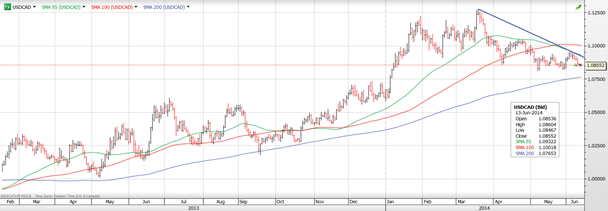- Iraq hostilities could lead to risk aversion
- Canadian Financial Stability Report same as before
- Modestly bullish USD/CAD outlook ahead for next week
While Friday 13th is regarded as unlucky by many, for FX traders it is a day to book some profits especially with the risk of escalating Iraqi violence threatening to spread into Turkey and a shift into risk aversion trades. WTI oil prices started to climb when news broke that a group of around 1,500 terrorists claiming to belong to the Islamic State of Iran and Iraq captured Mosul, a city of 2 million people. The U- trained Iraqi army scattered like cockroaches in lamp light.
The Economist reports that ISIS only has an Army of about 11,000 fighters which implies that the risk from these insurgents is manageable and current WTI levels should only be temporary.
The week that was
Tuesday's Reserve Bank of New Zealand (RBNZ) rate decision and statement kicked some life into Asian FX markets which spilled into NZD Crosses. The hawkish tone to the RBNZ statement in spite of what many believed were weakening economic fundamentals had analysts scrambling to revise their interest rate projections higher. NZDUSD jumped about 1.2 percent. Wednesday's UK employment report gave GBPUSD a bid but on Thursday when Mark Carney stated that a UK rate hike "could happen sooner than markets currently expect" sterling was really polished. Friday's Bank of Japan (BoJ) rate decision and Governor Kuroda's press conference delivered as expected which was enough to halt the slide in USDJPY, at least for now.
The week that will be
The Federal Reserve Open Market Committee (FOMC) meeting on Wednesday will dampen trading enthusiasm at the beginning of the week. Since Mr. Carney opened the door to tightening in the UK, the FOMC rate hike forecast "dot-plot" will be closely scrutinised. As important as this meeting is, it won't be the only show. It is "inflation week" in global markets with the Eurozone, UK, US and Canada all releasing CPI data. A soft EU CPI report should maintain the downward pressure on EUR/USD.
No rose coloured glasses for BoC governor
The Bank of Canada (BoC) governor, Stephen Poloz, won't ever be accused of looking at the Canadian economy with rose coloured glasses. Thursday's first ever press conference following the release of the semi-annual Financial Stability Report (FSR) provided further evidence of his concerns. He announced that the financial system risks remain elevated which is unchanged from the previous report. The very nature of an FSR is to look on the negative side although some people may question his motives for having an inaugural FSR press conference. (surely not to undermine the loonie.)
Earlier this week, the International Monetary Fund (IMF) and the Organization for Economic Cooperation and Development (OECD) expressed concerns that Canada has a dangerously overvalued housing market. Mr. Poloz conceded that "stretched valuations and some signs of overbuilding would expose the financial system to a sharp correction in house prices" while noting that the BoC still expects a soft landing. It appears that the USDCAD market was indifferent to the report and the press conference as it didn't provide any new information. At the same time it certainly couldn't be considered a ringing endorsement for the Canadian dollar.
Canadian dollar outlook
The loonie doesn't know if it is coming or going and that isn't likely to change next week. Canadian dollar negatives continue to add up. These include: the IMF and OECD reiterating concerns about a Canadian housing bubble, the BoC governor fixating on deflation risks, and mixed economic performance. However, none of these negatives are new or even news and are well imbedded in the current exchange rate.
The Canadian dollar positives include; firm and rising oil prices, Federal government budget surplus pending and improving outlook for US economic growth. Like the negatives, the Canadian dollar positives are not new or fresh, either. The key driver to Canadian dollar flows has been global position adjustment led by EURCAD selling. The European Central Bank (ECB) decision to cut interest rates, and by default weaken the currency, has breathed new life into a loonie that was looking terminally ill.
Lately, it seems that EUR/CADselling has stalled at support in the 1.4680-00 zone. Conversely, the risk of a "sooner than expected" UK rate hike has given GBP/CAD a lift which at worst will offset further EUR/CAD selling.
The intraday USD/CAD technicals have turned modestly bullish with the move above 1.0855 overnight which suggests further gains to test the downtrend from the June 5 high of 1.0955. (Currently 1.0890). The short-term downtrend from the March peak of 1.1270 remains intact while trading below 1.0920. There is strong support in the 1.0830-50 area ahead of additional support at 1.0810, The 100 day moving average is 1.1002 while the 200-day moving average resides at 1.0765.
The intraday shift to bullish USD/CAD combined with the loss of downward momentum in the 1.0830-50 support zone suggests that USD/CAD will revisit 1.0920 next week. 
